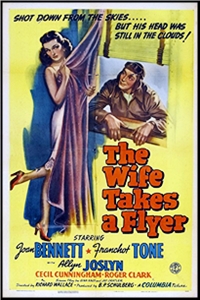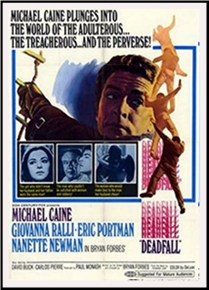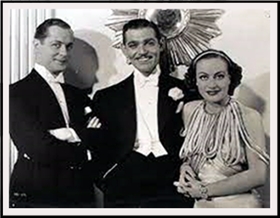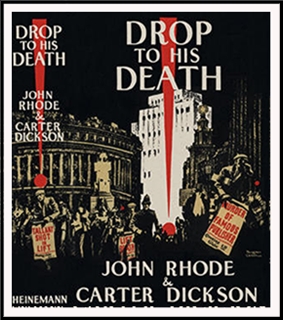May 2021
Monthly Archive
Mon 17 May 2021
Posted by Steve under
Reviews[10] Comments
KAREN KIJEWSKI – Kat Scratch Fever. Kat Colorado #8. G.P. Putnam’s Sons, hardcover, June 1997. Berkley, paperback, June 1998.
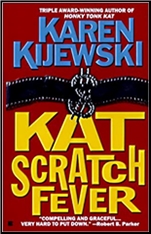
In her next-to-last recorded outing, Kat Colorado is hired to help determine if a well-known insurance agent committed suicide or not. The police think so; the man’s lawyer is not so sure, and his widow, a much younger woman, is completely distraught. Thinking it an extremely minor matter, she takes the case, but 350 pages later, both she and the reader have gone though a figurative wringer.
It’s a long and complicated case, in other words, and there are times when a list of characters after the title page would have come in very handy. (Do mystery novels ever do that any more?) It seems as though everyone in Sacramento has a deep dark secret that they’ve been keeping forever, and somehow a blackmailer, the same one in each instance, has managed to unearth all of them.
What’s different this time around is that all of the money — $10,000 at a time — goes to charity, a foundation that grants wishes to disadvantaged kids, and with one exception, the blackmailer does not come back for more. But when Kat’s investigation gets too close, he (or she) has no hesitation in striking back, in more ways than one.
Kat Colorado was a PI definitely in the Kinsey Millhone mode. For each of these two female Pis, their friends and family get all tangled up in the tales about them, and in this case for Kat, deeply involved in the case itself as well. Both tell their stories in a consistent conversational tone, and snarky and wittily at times as well, but if you prefer the loner type of detective, you’d best stay away.
Another possible flaw for you, as a potential reader of this book, may be in the detective work, if you perceive it that way. When Kat eventually comes to a dead end, as indeed she must, as none of the blackmail victims are willing to talk, her only recourse is to offer herself up as bait. We’ve all read that sort of recourse before, but you can’t convince mystery writers to do otherwise, since as smart as the killers always are up to then, it’s a ploy that always works.
Mon 17 May 2021
REVIEWED BY DAVID VINEYARD:
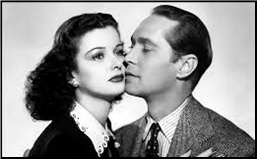
THE WIFE TAKES A FLYER. 1942. Franchot Tone, Joan Bennett, Allyn Joslyn, Lloyd Corrigan, Cecil Cunningham, Hans Conreid. Screenplay by Gina Kaus (her story) & Jay Dratler, with additional dialogue by Harry Segall. Directed by Richard Wallace. Available for viewing online on several sites, including this one.
With World War II coming at the end of the heyday of the screwball comedy of the Thirties, it was only natural that the new war movies would cross genres with the popular romantic comedies of only a year or so before, and perhaps natural too that the fit and the public reaction would be mixed.
While Lubitch’s To Be Or Not To Be with Jack Benny was the hallmark of absolute genius for the genre not everything worked quite so well, and even that classic met mixed reactions when it came out.
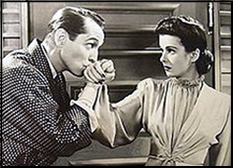
Even before the war there had been some uncomfortable if admirable attempts at mixing the two like Mitchell Leisen and Billy Wilder’s Arise My Love, a romantic comedy that turns quite dark and serious as the war intrudes or Leo McCarey’s Once Upon a Honeymoon with American stripper Ginger Rogers married to Nazi provocateur Walter Slezak encountering American radio journalist Cary Grant (who at one point comes close to being sterilized in a Concentration Camp) and ending with a jolly turn as Slezak falls overboard on a passenger liner on the way to practice his provocations in the States giving Grant, Rogers, and the ship’s Captain pause to debate whether they should rescue him … they don’t.
These films are a slightly different genre than out right comedies like All Through the Night or various versions of comedic stars battling comic opera Nazi’s (Cairo even does it to music as bumbling Robert Young sinks a German sub while American spy Jeanette MacDonald warbles), and as the genre goes none are stranger than 1942’s The Wife Takes a Flyer.
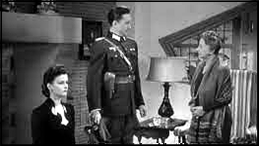
Allyn Joslyn is Major Zellfritz, a total Hitlerian idiot replete with a Sergeant whose only job is to massage his arm as he tires of Heil Hitler-ing. Along with every other Nazi in Occupied Holland he is out to find a flier shot down the night before who saw secret Nazi installations. His search leads him to the home of the Woverman’s whose daughter in law, the beautiful Anita (Joan Bennett) is divorcing their son who is due back from the sanitarium that evening.
Zellfritz is instantly smitten and moves himself in, which would be bad enough save that the missing flier, Christopher Reynolds (Franchot Tone), has just shown up hiding in the cistern, and in desperation gets passed off as the returning husband the insane Hendrik (Hans Conreid), and Reynolds is instantly smitten with Anita too.
Reynolds is playing madman and flirting, Zellfritz is blocking him and madly jealous, the Woverman’s (Lloyd Corrigan and Barbara Brown) only want to keep the Nazis from realizing they are hiding an Allied flyer, and Anita only wants her divorce the next day and to get out of the madhouse.
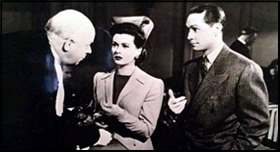
Meanwhile rather than be released Hendrik has broken out.
Oh, and of course Reynolds needs to make a clandestine meeting and arrange to get out of Holland so he can report on the secret installations he saw. But first the has to sabotage Anita’s divorce because he is so smitten with her he doesn’t want her to go away.
Before it’s over there is divorce proceeding where Reynolds goes completely nuts, Anita moves in with a home full of man crazy older ladies who get enlisted in Reynold’s mission, a public trial (for an assault the real Hendrick perpetrated) where Reynolds joins the Nazi Party, and all the time he and Anita are falling in love.
At no point does anyone address how American flier Reynolds and the other flier he meets up with happen to speak Dutch well enough to pass as natives among the Dutch or the Germans.
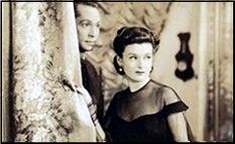
Granted screwball comedy operates on a different level than the mundane reality we all live in, but this film is almost surreal in its disregard for any kind of linear storytelling or human behavior. In most screwball comedy there are at least a handful of normal people to react against and poke fun at. Here everyone but Bennett is completely nuts, and even her character seems totally indifferent to WW II.
And that doesn’t even address Allyn Joslyn’s performance as Zellfritz, a broad even cartoonish interpretation that makes Sig Ruman look restrained. His face screwed up as if he had been sucking on alum, his walk strangely stiff, and his behavior better suited to a Daffy Duck cartoon than a human it is the ultimate comic opera Nazi in a genre where comic opera Nazi’s were the standard.
The problem is that at no point are any of the Nazis in the film even vaguely threatening. Granted To Be Or Not To Be was broad, but this never quite rises to that level of genius and instead is just strange, an odd relic of two genres that weren’t really compatible colliding head on and ultimately not making a lick of sense. It is fun, with that cast of actors it would almost have to be, but if you engage your brain at all you may find it slightly bruised by the effort to make sense of the goings on.
It’s hard to believe that no one at any point during the filming of this did anyone speak up and ask what the hell was going on.
Maybe they were afraid someone would tell them.
Sun 16 May 2021
A 1001 MIDNIGHTS Review
by George Kelley & Marcia Muller
DESMOND CORY – Deadfall. Frederick Muller, UK. hardcover, 1965. Walker, US, hardcover, 1965; paperback, 1984. Also: Fawcett Crest, US, paperback, 1967. Film: 1968, starring Michael Caine.
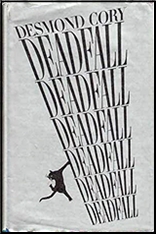
Desmond Cory (a pseudonym of Shaun Lloyd McCarthy) has published a wide variety of suspense fiction, including espionage novels, detective novels, and thrillers. He has a firm grasp of psychological principles, and his characters show considerable depth. The details of his settings – frequently Spain – are richly evocative and suggest careful research and firsthand knowledge.
He is best known for his books featuring British agent Johnny Fedora; in five of these, Fedora matches wits with Soviet spy Feramontov. There is a powerful tension in these novels – Undertow (1963), Hammerhead (1964), Feramontov (1966), Timelock (1967), and Sunburst (1971) – and their plots are complex and action-packed.
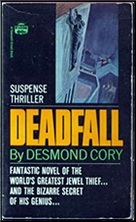
One of Cory’s best books, however, is a nifty caper novel, Deadfall. Set in his favorite locale, Spain, it features an unlikely trio of characters: Michael Jeye, an acrobatic burglar; Moreau, a genius who plans jewel heists; and Moreau’s wife, a beautiful and mysterious woman named Fe. As the three work together to steal a fortune in jewels, Jeye finds himself falling in love with Fe. This loss of emotional control is dangerous, both to their plans and to Jeye personally – especially since the relationship between Fe and Moreau is soon revealed to be not exactly as it seems.
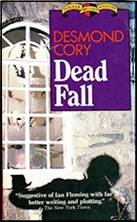
Against a background of professional crime, Cory weaves a thrilling plot with deep psychological undertones. The three complex personalities are caught up in deadly motion, and themes including incest and homosexuality emerge. The pacing of Deadfall is more deliberate than the nonstop action of the Fedora series, and the overall effect is haunting.
Deadfall was disappointingly filmed in 1968, with Michael Caine and Giovanna Ralli. Other Cory novels notable for their psychological depth are A Bit of a Shunt Up the River (1974), in which a sociopath escapes from prison; and The Circe Complex ( 1975), which deals with a former prison psychologist who finds himself imprisoned for a crime he didn’t commit.
———
Reprinted with permission from 1001 Midnights, edited by Bill Pronzini & Marcia Muller and published by The Battered Silicon Dispatch Box, 2007. Copyright © 1986, 2007 by the Pronzini-Muller Family Trust.
Sun 16 May 2021
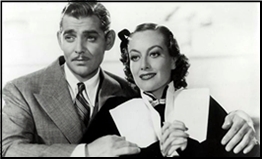
FORSAKING ALL OTHERS. MGM, 1934. Robert Montgomery, Joan Crawford, Clark Gable, Charles Butterworth, Billie Burke, Rosalind Russell. Director: W.S. Van Dyke.
I taped this by mistake. It was supposed to be some other Joan Crawford movie, but I watched it anyway. I’m not really a Joan Crawford fan, but this early in her career, I find her on-screen image much more pleasing than the hard-boiled one I picture her as in many of her later films. (In the early 30s she’s also lovelier to look at, if I might be permitted a small sexist remark.)
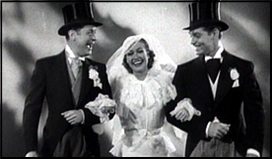
I’m not usually a Clark Gable fan, either. He always seems a little slick for me. I wonder how women today feel about him, watching his old movies now. Ladies, tell me: Is he still the “dreamboat†he was back then?
At any rate, this moderately entertaining love triangle amongst members of the champagne set – and note that Robert Montgomery makes up the third party in this regard – must have been the height of sophistication in its day. It still has its moments, but when it comes down to it, the immorality that’s briefly suggested stays firmly under the leash.
Did I mention that this was a comedy? And as such, Charles Butterworth – totally forgotten today – seems to have gotten all of the funniest lines.
– Slightly revised from Mystery*File #32, July 1991.
Sat 15 May 2021
Posted by Steve under
Reviews[10] Comments
LILIAN JACKSON BRAUN – The Cat Who Lived High. Jim Qwilleran #11. Putnam, hardcover, 1990. Jove, paperback, 1991.
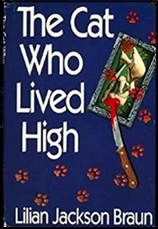
For the first two-thirds of this book I thought that this review I was going to write would be positive if not an out-and-out recommendation. Former reporter Jim Qwilleran and his two live-in feline companions, Yum Yum and Koko, have temporarily abandoned their home in Pickax City, up north in Moose County, and have headed for the dangerous wilds of Down Below (for which I have always assumed you could substitute the city of Detroit.)
Qwilleran has been asked to use some of his new fortune (tied up with the Klingenshoen Fund) to renovate a classic old apartment building,once the home of the rich and famous, but now on the verge of immediate takeover and conversion to new office towers and condos. And to investigate the building’s worthiness, he decided to take the penthouse accommodations for the winter.
In spite of the many free-spirits still living there, not surprisingly the Casablanca turns out to be a sad picture of urban decay. Yum Yum in particular does not take well to her new surroundings, and Koko’s nose for dirty work soon uncovers the fact that a notorious murder-suicide took place in the very apartment Qwilleran in now staying.
If Braun’s goal had been to write a humorous book about cats and life in the big city (which in part she has), the book would be a resounding success. It’s the unraveling of the mystery which, well, unravels. When the mystery finally (of necessity) takes center stage, you the reader are forced to realize that solving a murder by intuition (masculine as well as feline), ouija boards, and just plain good wishes is something that simply can’t be done, or at least not well.
In other words, the last third of the book self-destructs. I can’t think of a better word to describe it. The mystery is wound up so fast that (as far as I can tell) any thread of plot that is finally tied together is purely accidental. On his part, Qwilleran is totally content to head back to Pickax City. In a way, I don’t blame him. On the other hand, he certainly seems to leave a mess behind.
– Moderately revised from Mystery*File #32, July 1991.
Fri 14 May 2021
Posted by Steve under
Reviews[14] Comments
IT IS PURELY MY OPINION
Reviews by L. J. Roberts
ANDREW MAYNE – Black Coral. Underwater Investigation Unit #2. Thomas Mercer, paperback, February 2021.
First Sentence: Everyone is looking at me funny.
The Underwater Investigation Unit is called out to a submerged van at Pond 65. The passenger has been recovered; but Detective Sloan McPherson, the team’s top diver, needs to recover the driver. Rather than one, she finds three bodies in the van, and evidence of a fifth person having been involved. The investigation puts McPherson and the UIU on the trail of the serial killer, while also trying to catch a thief stealing millions of electronic equipment off mega-yachts.
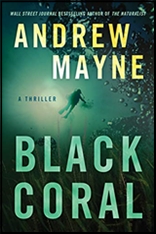
Mayne has a great voice layered with wry humor— “‘If you have any questions, please contact us through our website,'” George concludes. … ‘We have a website?’ I ask in a whisper.” He is a true storyteller who creates wonderful characters that play into one . One wants to share passages of his writing with others. Not every male author writes women well. Mayne is one who truly does, and it is a pleasure to read.
Slone is fully dimensional. There is a nice injection of the character’s personal life which adds to balance to the story, injecting light into the dark. There is realism in admitting no one is a perfect parent. one provides compelling She is introspective both about the case— “I see two different men in front of me. One is the monster. The other is the victim. The victim didn’t make the monster, but it sure did nurture him.”, and her life as a cop— “…where do I go from here? Catching the New River Bandits was a good thing, but in no way deeply fulfilling.”
Having Sloan be an archeologist, as well as a diver and cop, brings dimension to the character and opens interesting doors. The plot is very well done and filled with surprises, yet none of them feel contrived. The things one learns are unusual.
Periodic references to events from the first book, don’t distract from the current story, nor does the crossover reference to Mayne’s Theo Cray series. This book stands nicely on its own merit.
Of the two cases, one is fairly straight forward, but the second takes one down a surprising, twisty path with some definite “Oh, my” moments. Although the main plot is about a serial killer, the book is far more suspenseful than gory.
Black Coral is an excellent read full of humor, suspense, wicked good twists, and a very unexpected ending.
Rating: Excellent.
The Underwater Investigation Unit series —
1. The Girl Beneath the Sea (2020)
2. Black Coral (2021)
3. Sea Storm (2022)
Thu 13 May 2021

MURDER AT THE WINDMILL. Grand National Pictures, UK, 1949. Released in the US as Murder at the Burlesque by Monogram Pictures (1950). Garry Marsh (Detective Inspector), Jon Pertwee (Detective Sergeant), Jack Livesey, Eliot Makeham, Jimmy Edwards, Diana Decker, Donald Clive. Screenwriter/director: Val Guest.
The Windmill Theater, that is, a real life performance hall in London, known at one time for a nude girls revue, permitted by the authorities as long as the girls did not move. This being a movie, the closest it comes to anything as risque as that is the inclusion of a fan dancer as one of the acts, with very large feathery fans.

The movie begins as the theater is closing down for the night, and the cleanup crew finds a dead man sitting in the front row, killed by a bullet shot by someone on the stage, or so the inspector from the Yard quickly deduces.
His method of finding the killer? Have all of the acts from that night’s program recreated onstage, even if it takes all night.

And as an immediate result, most of the movie’s 65 odd minutes are taken up by singers, dancers, one lone comedian, complete with trombone, and the aforementioned fan dancer. This is not a bad thing, mind you, as many of the performers on stage are members of the actual singers and dancers at the Windmill at the time of the movie’s making. Finding the killer – for of course this really is a mystery movie – doesn’t happen until the end of the very last repeated number.
Of some note, perhaps, is seeing Jon Pertwee, a future Doctor Who, as the rather diffident police sergeant on the case, or at least he is in comparison to Garry Marsh as the blustery inspector in charge. It all makes for very light family entertainment, especially resonant to those who still remember the era, now long gone by. You needn’t go out of your way for this one, but on the other hand, it’s easily found on YouTube.
Wed 12 May 2021
Posted by Steve under
Reviews[14] Comments
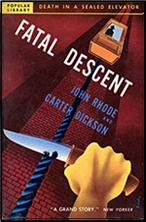
JOHN RHODE & CARTER DICKSON – Fatal Descent. Dr. Horatio Glass & Chief Inspector Hornbeam #1. Dodd Mead, US, hardcover, 1939. Popular Library #87, paperback, 1946. Dover, US, paperback, 1987. Published first in the UK as Drop to His Death (William Heinemann, hardcover, 1939).
Carter Dickson is of course better known as John Dickson Carr, the most famous locked-room mystery writer of all time, and the locked room in this collaboration with John Rhode, author of many many Dr. Priestley novels, is a doozy. It’s an elevator, and to all practical purposes, a hermetically sealed elevator, into which a man steps in alone at the top floor of a five story office building. When it reaches the bottom floor, he is found dead, shot to death in the head.
As the elevator passes each floor on its way down, no one is able to stop the car either to get in or get off. Nor could have anyone been able to stand on the roof of the car. He was alone all the way down, but someone managed to kill him anyway. The question is how? And of course, secondarily, why?
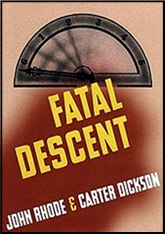
This was the only pairing in print of the two authors and of the two detectives who handle the case. In this instance, it is the professional, Chief Inspector Hornbeam whose technique depends on interpreting facts, while Dr. Glass relies on people, psychology and motive. It is the latter, however, who comes up with more than possible solution, one of which (in my opinion) is as good as the real one, if not better.
But of course, which checked out, Dr. Glass’s solution does not fit the facts, and that is what finely detailed detective novels depend on. In that regard, this book delivers the goods one hundred percent. Unless uncommonly diligent, the reader will still be fooled every step of the way. My only regret is how complicated the murder plan was, even though the authors do a fine job in trying to explain why the killer had to do it the way he did. (UPDATE: For more on this, please see the comments that follow this review, especially #12.)
I do not know which author wrote what in this novel, or if one did all of the plotting and the other did the writing. I suspect it was Carr who did the bulk of the work. I recognize his style in detail and humor, but I may be swayed in this regard by having read much more of his work than I have of Rhode’s. Either way, this is a fine example of late 1930s detective fiction writing, and especially if you’re also a fan of locked room mysteries, you should not miss this one.
Wed 12 May 2021
Posted by Steve under
Reviews[7] Comments
Two GOLD MEDAL Originals dealing
with sex and violence down Lou’siana way.
REVIEWED BY DAN STUMPF:
â— DAY KEENE – Notorious. Gold Medal #372, paperback original, 1954.
â— CHARLES WILLIAMS – Hill Girl. Gold Medal #141, paperback original, 1951.
In Notorious, Carny boss Ed Ferron finds his show mysteriously shunned by the locals in Bay Bayou on opening day. He’s just coming off two rain-out stands, and a bloomer here will send him into bankruptcy. Keene fills in Ed’s background at this point. He’s an ex-con, having done three years hard labor for killing a man he found in bed with his wife — only to discover at his trial that the unlucky deceased was just one in a long and continuing line of infidelities.
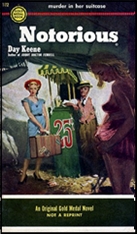
This has made him leery of cops and women, but when he sees young Marva Miller — returning home after two years in the Big City and a failed career as a nightclub singer — being molested by the station master at the depot, he wades in, decks the masher and offers the lady a ride into town, where they’re both inexplicably harassed by the locals. A trip to Marva’s ol’ homestead finds her drunkard dad recently murdered, money missing, and someone taking shots at them. They call the police, and in another unpleasant surprise, find themselves accused of the murder.
The story that unfolds is a bit predictable, including the inevitable death of a would-be informer (“Meet me at Nine, and bring money with you. What I know will blow this case wide open!â€) and a crucial plot twist strained my credulity a bit too far, but Keene keeps a fast pace, builds tension, and his evocation of carnies and small-town folk (Variously termed Gilhoolies, Puddle-Jumpers, and Thistle-Chins) is vivid if not always quite…..
Well what’s the word I’m looking for?
What it comes down to is a tendency of some writers to paint small towns as inherently corrupt, like smaller versions of Chicago, where Day Keene (born Gunard Hjertstedt) grew up in the 1920s. My own experience of small towns, while not extensive, leads me to believe that corruption is harder to get away with in a place where everyone knows your business. I could be wrong, but it seems to me that individuals are like any other commodity: valued more highly where there’s fewer around.
This folksy attitude comes across colorfully in Charles Williams’ Hill Girl, which starts with Bob Crane returning to his rural home town after two years in college football and a failed career as a boxer. When Bob’s father died, he left his considerable assets to Bob’s brother Lee, but Bob’s grandfather left him the modest farm where he spent his boyhood summers, and he has a yen to get back to it.
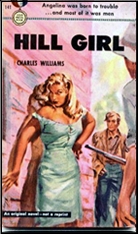
One doesn’t think of Gold Medals as bucolic, but there’s no other description for the feel of getting back to the soil Bob enjoys (and Williams evokes.) He gets along with his nearest neighbor, Sam Harley, contracts with a decent couple to help out on shares, and generally refreshes his soul as he works the land.
The fly in the ointment, and the crux of the plot, is Bob’s brother Lee, wild, hard-drinking and married but nursing a letch for Sam Harley’s daughter Angelina. Bob sees enough of the relationship to nourish a grudge against the girl, who treats him with heart-felt indifference, but when things boil over and Sam Harley comes gunnin’ after Lee, Bob steps in and tells Sam he was the one Sam saw runnin’ away with his pants down.
Williams injects a telling note of understanding here. Sam knows Bob is lying, but the lie will save face for all concerned, so he accepts it. All things considered, a live husband is better than a dead philanderer and facing a murder rap.
So now the story centers on the uneasy relationship between shotgun-wedded Bob and Angelina, and here Williams crafts a nicely readable balance between their finer feelings and the fighting, drinking, and other Manly Stuff essential to any paperback original. And having resolved this, he neatly turns the plot back to Lee, and his passion for his brother’s wife.
I don’t want to give anything away, so I’ll just say that the situation develops with considerable excitement, and includes a magnificent scene that captures the edgy tension of a drunk with a loaded gun.
No one did this sort of thing better than Gold Medal in those days, and I mourn the passing of this fast, brilliant writing wrapped in gaudy covers at the drugstores of my childhood.
Tue 11 May 2021
REVIEWED BY DAVID VINEYARD:
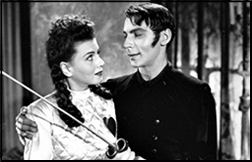
THE WIFE OF MONTE CRISTO. PRC, 1946. John Loder, Lenore Aubert, Fritz Kortman, Charles Dingle, Eduardo Ciannelli, Martin Kosleck, Fritz Feld, Eva Gabor. Screenplay by Dorcas Cochran, Edgar G. Ulmer, and Franz Rosenwalk (Francis Rosenwald) suggested by the novel by Alexandre Dumas. Directed by Edgar G. Ulmer.
Almost from the start there were sequels to Alexandre Dumas mega selling The Count of Monte Cristo including The Daughter of Monte Cristo and The Treasure of Monte Cristo by Jules Lermina published orginally as by Dumas himself. The Wife of Monte Cristo is not a sequel, but a retelling, adding a dash of Zorro and casting Haydee, Dantes Indian ward who is a key part of his revenge plot, as the wife of the title.

The time is 1832, the place France where corrupt government is opposed by the mysterious masked man known as the Avenger. The Prefect of the Police, de Villefort (John Loder) has two reasons to stop the Avenger, one he ruined his father, the other because he is the head of the corrupt elements in the governent backed by the wealthy Danglars (Charles Dingle) and Malliard (Fritz Kortman) who are both part of a plot to sell contaminated medicine during an outbreak of fever.
De Villefort has set a trap for the Avenger, and it very nearly works when his men ambush the Avenger and his hand is wounded. Now de Villefort is sure he has the man he suspects is the Avenger, the mysterious and wealthy Edmund Dantes, the Count of Monte Cristo (Martin Kosleck).
Monte Cristo manages to outwit de Villefort, going out of town to his hunting lodge and leaving his beautiful wife Haydee (Lenore Aubert) in charge and in contact with the Avengers legion of men.
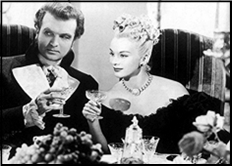
But de Villefort still suspects Monte Cristo and the only way to keep him off balance is if the Avenger appears while Monte Cristo is gone so Haydee chooses to don the mask and black costume of the masked hero.
Meanwhile de Villefort, still certain Monte Cristo is the Avenger, romances Haydee enlisting Mme Malliard (Eva Gabor) in his game to set a trap for the count. But for a time Haydee manages to outwit him, even capturing, putting on trial, and executing Malliard under de Villefort’s nose (in the best sequence of the film shot in smoky dark inns, wine cellars, and on Parisian roof tops), which results in Haydee being arrested, and now it is up to Monte Cristo to return from his hunting lodge and free his wife and avenge his honor as de Villefort has discovered from his spy (Fritz Feld) Monte Cristo is Edmund Dantes.
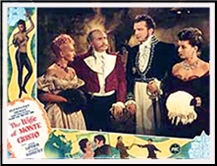
All this is standard cloak and dagger, and done on a low budget, but in this case done stylishly by director Edgar G. Ulmer who takes a fairly strong script, an interesting and intelligent heroine in Aubert, who is convincing equally in cape and mask and low cut gown, a dashing and despicable villain in Loder, and a surprisingly dashing and adept hero in Kosleck, who is off screen for much of the film, but returns in time to outwit de Villefort and confront him in his own palace in a well staged duel to the death. Considering Kosleck is best remembered for low budget villainy he is quite good as the swashbuckling mystery man.
A better than usual supporting cast of Kortman, Dingle, Gabor, Ciannelli, Anthony Warde, and Feld add to the fun while Bruce Lester and Robert J. Wilkie are unbilled in small parts.
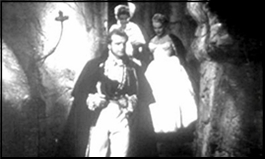
Virginia Christine has a nice bit as a woman who hides Monte Cristo from the soldiers.
Mostly it is Ulmer who makes this worthwhile. While I don’t quite hold with the auteur theory of Ulmer’s genius, he was capable of making the most of a low budget, poor lighting, inexpensive sets, and a feel for German Expressionism. Here the directors eye and ability to make the most of very little combined with a decent cast and the usual mix of desirable women, flashing swords, swirling cloaks, and masked heroes works better than you might expect.
This is by no means a great film, but it holds its own with better known and better financed sequels to Monte Cristo like the two Louis Hayward outings The Return of Monte Cristo and The Son of Monte Cristo. Considering those two are well respected among fans of swashbucklers that’s saying quite a bit for this film.
« Previous Page — Next Page »






